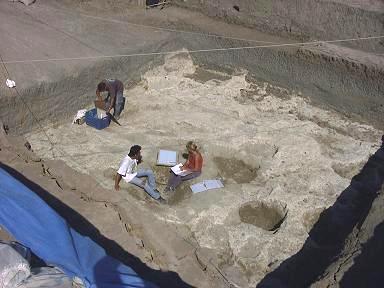Excavations in the KOPAL Area
from archive report
During August and September a trench was excavated to the north of the mound in order to gain information about what was happening away from the main site. There was 2m of Early Bronze Age and later alluvium sealing a Late Neolithic/Early Chalcolithic buried land surface with a fire installation. This sealed a layer of backswamp clay, which was created by the periodic seasonal flooding of the area. Under this were a number of Early Neolithic intercutting pits which cut the underlying lake marl and presumably represent the quarrying of marl and sand for building purposes (Figure 13). These lower deposits did not contain and pottery but were rich in animal bones and decorated fired clay objects (Figure 21) whilst chipped stone and human bone were found occasionally. A single posthole may indicate the presence of some form of structure lying mainly outside the excavation area and there was evidence for cereal processing. |
 Figure 13: The Kopal area, showing pits in the lake marl |